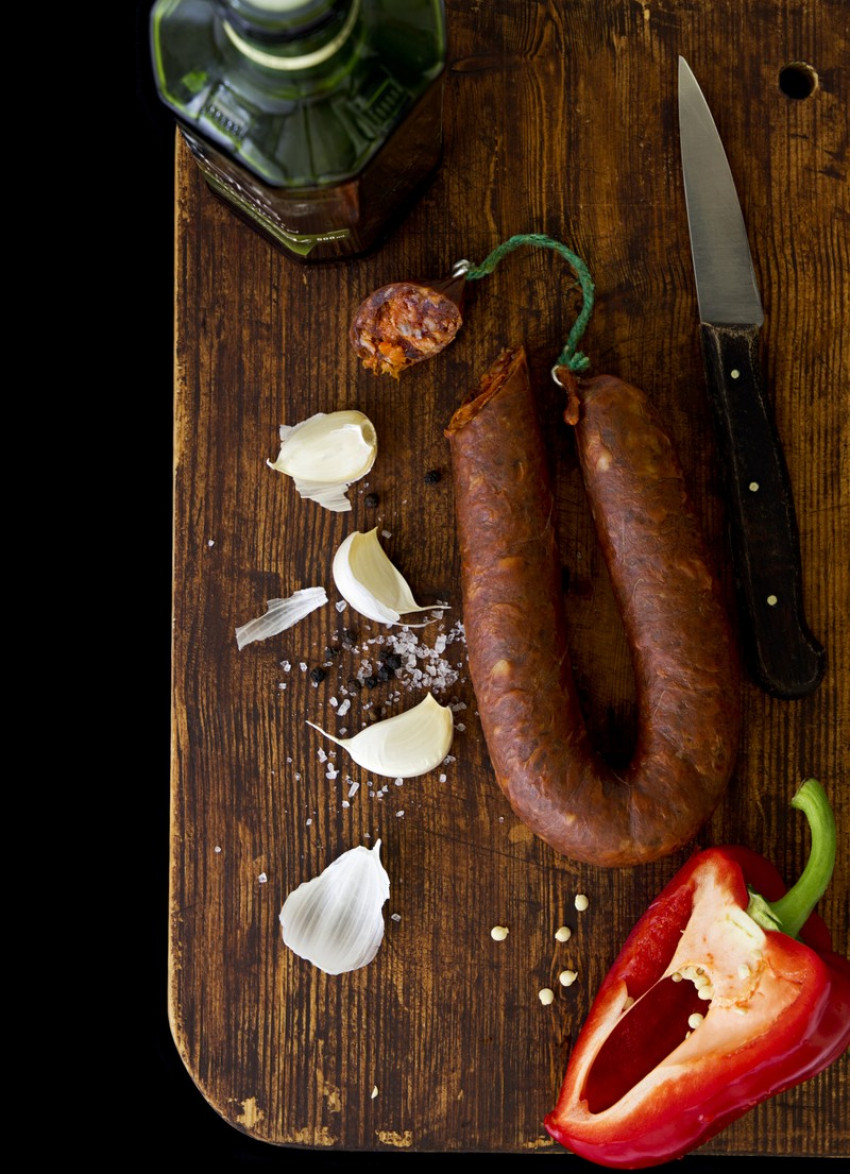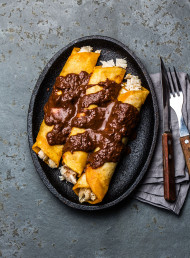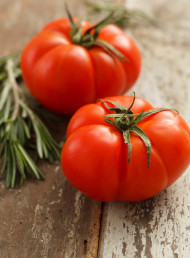Pantry essentials: Spanish

Key ingredients to have on hand for Spanish cooking…
Anchovies and boquerónes – The coastal towns of the Cantabria province in Northern Spain are renowned for producing first class anchovies and local fishermen begin in spring when the silvery fish are plumpest. The time-honoured anchoada method of processing used in the region is labour intensive but results in tender anchovy fillets prized for their dark meat and intense flavour.
The fish are cured in brine and stored in wooden barrels under a heavy weight for up to six months. They are then rinsed, hand-dried and each fish is divided, again by hand, into two fillets and boned. Finally they are carefully packed into cans or jars (ensuring that no fillets are broken) and covered with either olive or sunflower oil to preserve them.
Fresh anchovies (not cured in brine) are known as boquerónes or white anchovies. Usually boquerónes are marinated in fillet form in vinegar which bleaches them and imparts a distinctive flavour and colour. They are then packed in a mixture of oil, vinegar, herbs and garlic. Unlike salted anchovies, boquerónes have a mild, pickled flavour and can be eaten as is, or baked.
Calasparra rice – The rice grown around Calasparra is the traditional base for paella. Medium-grained and highly absorbent it was the first Spanish rice to be protected by the appellation of Denominacion de Origen (D.O), the European Denomination of Origin.
This ancient strain of rice owes its unique properties to the conditions in which it grows and a special cultivation system developed over many centuries by local farmers. Unlike usual rice fields, it is grown at high altitude in the mountains of the Spanish province of Murcia. Pure, cool water is delivered via aqueducts first built by the Romans. The cooler conditions delay the ripening of the grain and it is this lengthy maturing process which produces the distinctive and highly dehydrated rice kernels. Bomba is one variety of this premium rice, but is not readily available in New Zealand.
Capers and caperberries – Capers lend a characteristic piquant flavour to Spanish food. The caper is the small, heart-shaped flower bud of the caper bush, which grows wild in rocky outcrops in the hot climate of Murcia. The pink and white flowers have a fleeting life: they open in the early morning and are dead by midday, but must be picked by hand while in bud. On the same day they are pickled in brine for two months. The sharp taste develops after this brining process when the capers are stored in wine vinegar. The delicate buds are sorted by size before they’re sold, either pickled in jars, or dried and salted. The smallest capers are the most aromatic and expensive.
Caperberries are the fruit of the caper bush and are harvested after the flowers. Delicious, but coarser and less tasty than capers, they are usually preserved in brine and are generally served in the same way as olives. Capers packed in salt should be rinsed well before use.
Cazuelas – A cazuela is the ultimate multi-purpose oven to table ware. These traditional and rather beautiful Spanish terracotta dishes are made from high quality clay and come in many sizes: from tiny 8 or 10 cms for serving tapas or baking crema Catalana, to large, deep dishes which can be used on direct heat, just like a frying pan, to sauté, roast or bake in. The organic nature of cooking in clay yields food that is much more flavoursome than that cooked in steel. Before the first use on direct heat, soak the cazuela in water and then (depending on how often it’s used), each time thereafter for a shorter period. Spanish cazuelas are available in a range of sizes at specialty food and homeware stores.
Cheese – There is a variety of Spanish cheeses sold in New Zealand from time to time, two of the most commonly available are Manchego and Cabrales. Arguably Spain’s most famous cheese, true Manchego is made only from the whole milk of Manchega sheep reared in the La Mancha region, and was originally eaten only by shepherds. It is now protected by D.O labelling and can be identified by the trademark herringbone markings on the side. The cheese is matured for a minimum of 60 days (fresco) and up to six months (curado). The flavour deepens with age and it is typically eaten on its own or served as a dessert with fruit or membrillo. It is also wonderful paired with red wine or a fine sherry.
Also protected by D.O. status, Queso de Cabrales is a strong blue cheese produced in small villages in the Picos de Europa mountain range. This three milk cheese is made with a mixture of unpasteurised cow’s milk, mixed with goat and sheep milk. Cabrales gets its characteristic blue veining and flavour from the local limestone caves which form natural maturing chambers. These remain well ventilated by cool winds throughout the year. Under these conditions bacteria, yeast and the fungus in the caves (similar to Roquefort fungus) act on the cheese’s metabolic process. After six months a firm blue-veined cheese results. Traditionally this would have been wrapped in moist maple leaves, however due to E.U. regulations it is now sold in foil stamped with a leaf motif.
Guindillas – These long, moderately hot Spanish chillies are picked while still green. They are commonly found in the Basque country and have a wonderful flavour and are most commonly sold whole, preserved in sweet vinegar. Guindillas pair well with foods where moderate heat is required or can be used as part of a tapas platter with charcuterie or cold meats.
Jamon – Several different traders around New Zealand import Spanish ham products. For more information on how jamon is made see page 58. The following is available in New Zealand:
Jamon Serrano: imported pre-boned and then sliced by machine. Similar to Italian prosciutto.
Jamon Iberico de Bellota: imported with and without the bone. Generally the product available to the public is machine-sliced from deboned meat. However, it may soon be available sliced to order off the bone at some gourmet food stores. Hand-sliced ham has a different appearance from machine-sliced.
Legumes – Legumes form the basis of many substantial Spanish dishes such as the traditional stew cocido and in platos de cuchara (dishes eaten with a spoon). The chickpea or garbanzo was originally a native of ancient Persia, but the tender chickpeas produced in the Castilian, Andalusian and Extremadura regions have been adopted as a local delicacy. There are also around 20 indigenous varieties of bean, some of which are available pre-cooked in jars.
Mebrillo quince paste – Quince paste, known as membrillo, is a thick, sweet paste made from pureéd cooked quince, which are typically grown in Andalucia, dubbed ‘the fruit bowl’ of Spain. With the addition of an acid and sugar, or more traditionally honey, the cooking process transforms this fragrant fruit into a delicately flavoured and attractively coloured pink gel. Due to the relatively high pectin content membrillo holds its shape when cut or sliced. It shares a wonderful affinity with cheese, particularly rich sheep’s milk cheeses such as Manchego. Quince paste can also be melted into a sauce, or used on its own as a glaze for sweet and savoury dishes.
Nuts – More than 200,000 tons of almonds are produced in Spain every year, and when in blossom the trees lend the coastal regions of the Mediterranean a pink and white hue. Almonds are harvested by hand using huge cloths spread underneath the trees, but processing is now largely done by machine. Almonds are commonly eaten as a salted snack with drinks, and are used extensively in Spanish cooking, in both sweet dishes such as turron (Spanish nougat) and savoury dishes, where they are often toasted and ground to thicken sauces. Spain’s smooth, round Marcona almond is highly regarded for its superior flavour.
Spain is one of the world’s largest hazelnut producers with production concentrated in Reus in the province of Tarragona (an area protected by D.O status). Hazelnuts are used in many Spanish recipes and as an essential element in the confectionery industry.
Spanish pine nuts come from the Stone Pine (Pinus pinea) which has been cultivated for its nuts for over 6,000 years and harvested from wild trees for far longer. Identifiable by a smaller kernel, they have a much richer flavour than those commonly available in New Zealand which are sourced mostly from Asia.
Olives and olive oil – See p 52.
Paella pan – This large, steel pan gives the Valencian dish its name. The pan’s large surface area is crucial as it allows the liquid in which the rice is cooked to simmer away, leaving a layer of crunchy brown rice on the bottom. A pan for four people should be around 30 cm in diameter, while a 40 cm pan will cater for eight to ten people.
Piquillo peppers – Piquillo peppers begin as rather modest, bitter capsicums but through roasting are transformed into sweet, fiery delicacies. The small, hot peppers are dark red and charred using a traditional method over an open wood fire. The pimientos de piquillo are then seeded and soft cloths are used to remove every trace of the blackened skin laboriously by hand. Finally they are canned either whole or in pieces marinated in olive oil. The smoky tang from the wood fire and the spicy nature of this variety of pepper combine well with seafood, fish and vegetables. They are delicious stuffed or added to soups or sauces.
Saffron – Saffron has been used since ancient times and continues to be the most precious and expensive spice in the world. Some 70 per cent of the world’s saffron is grown on the high Castilian plateau. The delicate dark-red threads are the dried stigmas of the lavender-coloured autumn-flowering crocus (Crocus sativus Linnaeus). Farmers handpick thousands of the flowers over a period of six weeks and workers then separate the reddish threads from the stigma of each flower, again by hand. Around 200 crocus flowers are needed for a single gram of saffron. The fresh stigma perishes quickly so it is then dried over a fire.
The wonderfully floral, almost earthy aromas and flavour of saffron are used mainly in Spanish paella, broths and fish dishes. The delicate threads should be crushed between the fingers or with a mortar and pestle and then softened with a little water before adding to dishes. Even tiny amounts impart an intense yellow colour – it becomes bitter in excessive doses. Saffron is available in threads, tips or powder and should be stored in a dry place away from light and consumed within three years to conserve the flavour. Saffron threads should be dark red with no colour variation. See Dish issue #7, p.117 for more.
Sausages – The pig enjoys unparalleled status in Spain for its use as a food source. Indeed it is so venerated that in many areas the animal is blessed by the village priest before it meets its maker. Following a long tradition, once a year farmers will set aside a weekend for the home butchering ceremony (mattanza). A region’s climate determines what happens to the sausage after it has been made. While sausages and hams can be air dried in the arid south and west of Spain, it is usually too damp for this in the Atlantic north. As a result, most types of sausage and ham are dried for a short time then smoked as well. Spicy oak wood chips are favoured for smoking and this can take ten days or more. The preservation process is particularly important as traditionally the sausages had to last until the next butchering ceremony – an entire year.
The ‘star turn’ among Spanish sausages, chorizo is believed to have originated in Extremadura. It comes in many varieties: thick and thin, plain or smoked, as an exquisite tapa with a firm texture and great deal of lean meat, or a softer, fattier consistency to flavour stews and grilled dishes. Depending on the type of chorizo, lean pork and pork fat is chopped up in varying proportions and is kept in a mixture of seasoning for two days – typically garlic, salt, herbs and pimentón (Spanish paprika – see below) which gives chorizo the distinctive deep red colour and sweet smoky flavour. The oils in Spanish paprika also mean the sausages will keep longer. A dash of white wine is often added as well, to accelerate the natural fermentation process. This gives the chorizo its typical, slightly acidic taste. A variety of imported and locally made chorizo is available in New Zealand.
Akin to black pudding, morcilla is a very rich, northern Spanish blood sausage and a firmly established feature of Iberian cuisine. Made from pig’s meat and fresh blood, they are often flavoured with onion, garlic, cinnamon and cloves. All blood sausages are boiled before being hung to dry, and are then sometimes smoked. They are often added to stews, casseroles and stuffings. Blood sausage, along with chorizo, is the main ingredient of many stews, such the Castilian cocido.
Sherry vinegar – Originally a by-product of Spain’s sherry industry, today it is made from the finest sherry. With its own D.O designation, the production and quality of vinaigre de Jerez is carefully monitored and follows an age-old method. During the fermentation stage, acetic acid bacteria (the major acid in all vinegar) transform the wine into vinegar. It is then matured using the solera method – the ageing process also employed in sherry production – whereby vinegars from different vintages are gradually mixed. The American oak barrels which originally house sherry combine with this unique method of production to create a golden hue, wonderful depth of flavour and a soft quality.
Standard sherry vinegar must undergo ageing for a minimum of six months and have a minimum of seven degrees of acidity. Vinagre de Jerez Reserva has a minimum of 2 years ageing in wood while Vinagre de Jerez Gran Reserva has a minimum of 10 years ageing in wood. The style of sherry vinegar depends mainly on the grape variety used to produce the wine it is made from. Palomino is the most common grape varietal and the vinegar is often produced from a younger wine. Vinegar from Pedro Ximénez grapes are often, like the wines, very sweet and have a sweet raisin nose. Small amounts of sherry vinegar are produced from the Moscatel grape.
Smoked paprika – The vibrant red and smoky flavoured Spanish paprika or pimentón was originally an import. The paprika pepper was originally brought to Spain from the Americas by Christopher Columbus. Today the finest and most famous paprika powder in Spain, pimentón de La Vera, is produced in the northern part of Extremadura. In this fertile region various types of pepper are cultivated, each with varying degrees of spiciness. As a result, Pimentón de La Vera is found in three different varieties: the milder, sweet paprika pimentón dulce, medium-hot, bittersweet pimentón agridulce and the fiery-red, hot pimentón picante. Once harvested, the peppers are smoked for around two weeks over oak which gives the characteristic flavour, and are turned by hand daily. Once dried, they are sent to one of the small paprika mills in the region where they are stone-ground to preserve the flavour and colour. Pimentón is perhaps most noticeably used in chorizo but its delicious flavour and colour enhances a variety of Mediterranean-style dishes. Paprika can be stored for up to two years. The smoked paprika from La Vera was the world’s first pepper spice to be given a D.O. status.
Tinned fish and seafood – The cold waters of the Atlantic are home to a rich variety of fish species of extraordinary quality. Mackerel thrive in this habitat and huge numbers are caught by the Spanish fishing fleet. The distinctive full-flavour of this very oily fish makes tinned mackerel a hugely popular export, particularly in Europe. Octopus is an inexpensive delicacy that is handled very carefully during processing to ensure the meat remains moist and tender. The slow-cooked tentacles of Spanish octopus are often packaged and preserved in extra virgin olive oil. Moist sardines, or pilchardus, from Galicia (on the Atlantic coast of Spain) are particularly valued as they are processed and packed in olive oil on the day they are caught. The Spanish prefer to let sardines mature in the can or jar as long as possible to let the depth of flavour increase. Once opened, they can be served simply with a squeeze of fresh lemon. Canning tuna isn’t considered sacrilege in Spain. The delicious flaky pale flesh of the albacore tuna is savoured for its full flavour and is sold packed in olive oil in tins and jars bearing the Spanish names atun blanco or bonito del norte. The filleted belly flesh, called ventresca, is particularly valued for its subtle taste and firm texture.
latest issue:
Issue #120
As the days become shorter, and the nights cooler, the latest issue is perfectly timed to deliver delicious autumn dishes. From recipes using fresh seasonal produce such as feijoas and apples, to spectacular soothing soups and super-quick after-work meals in our Food Fast section, we’ve got you covered. With Easter on the horizon, we feature recipes that will see you through breakfast, lunch and dinner over a leisurely weekend holiday, and whip up chocolatey baking treats sure to please. We round up delicious dinners for two and showcase a hot new Korean cookbook before heading south to Dunedin to check out all that’s new in food and dining.The latest issue of dish is on sale NOW at all good bookstores and supermarkets – don’t miss it!




